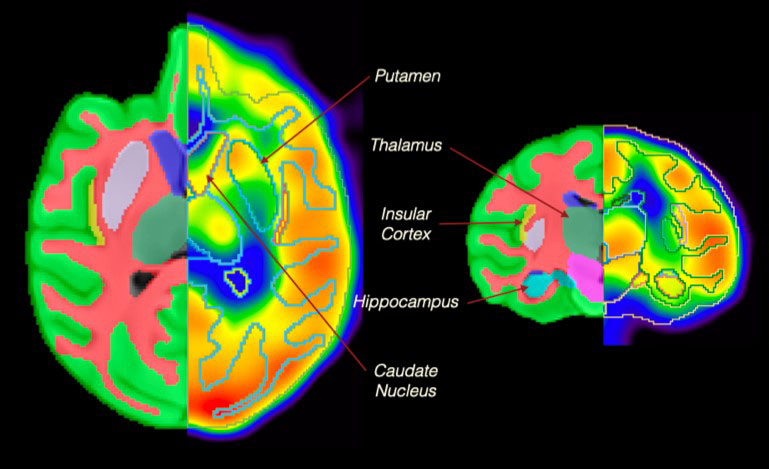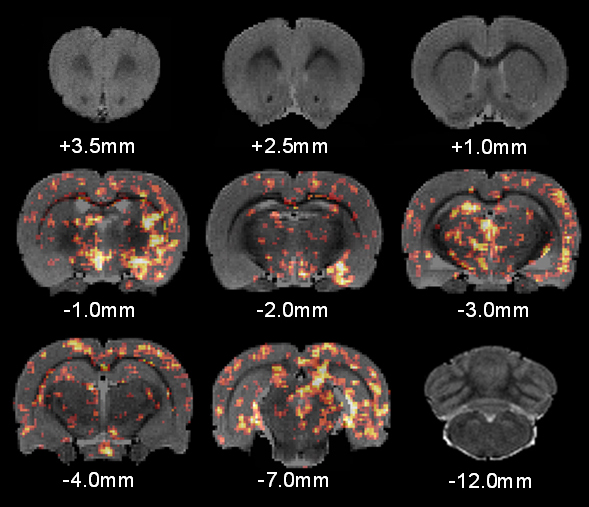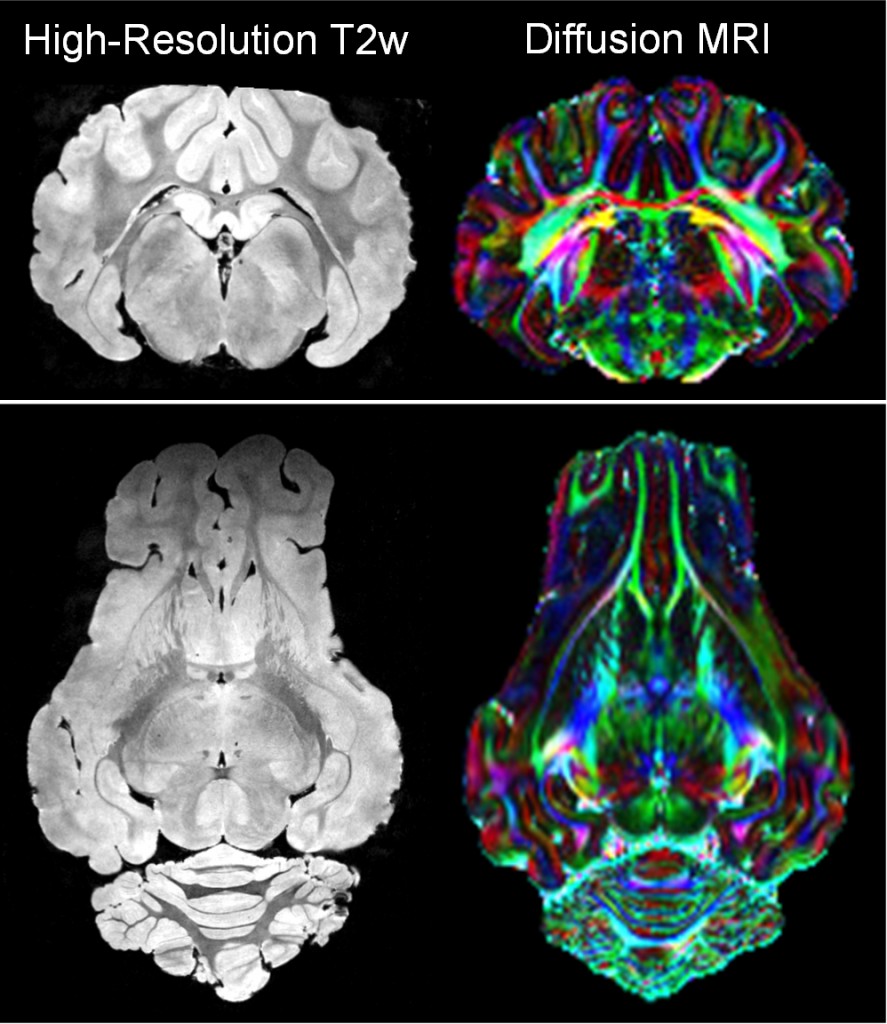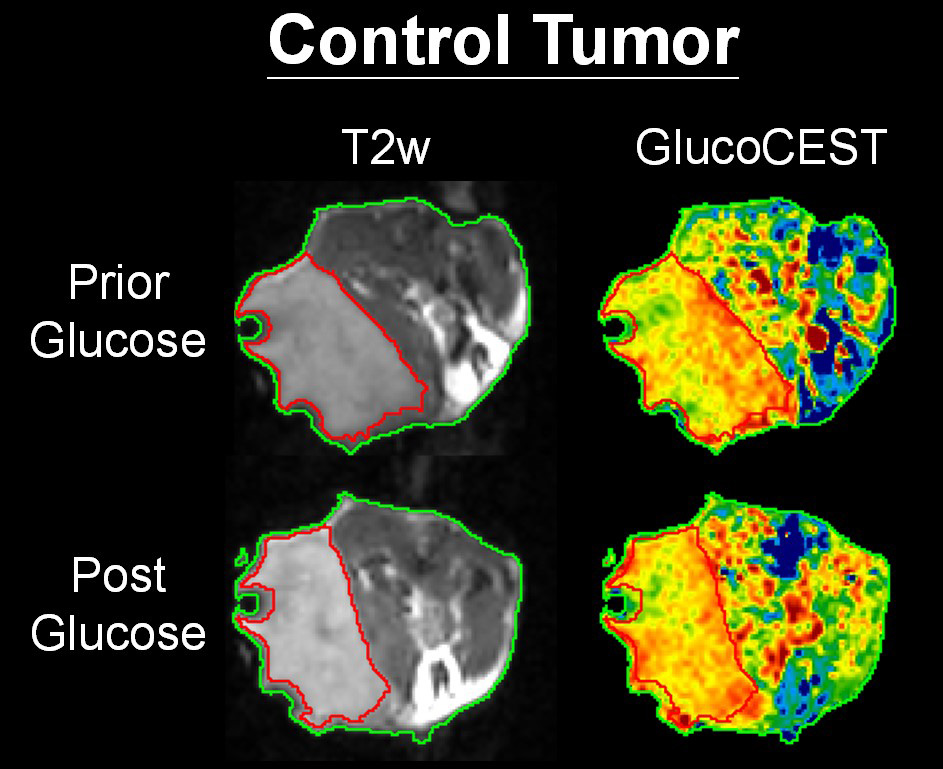Research: Biomedical Imaging
The Molecular Imaging Laboratory research focuses on in vivo imaging using MRI, PET/CT, and optical fluorescent and bioluminescent imaging. In particular, we are interested in using molecular imaging techniques to study mechanisms of image contrast enhancement, improvement of sensitivity and specificity of tumor detection, and applications of diagnostics using small diseased animal models.
Research Highlights
Tsang-Wei Tu, Department of Radiology; Yeona Kang, Department of Mathematics; Nobuyuki Ishibashi, Cardiac Surgery Research Laboratory, Children’s National

This project aims to create a three-dimensional MRI brain atlas for large laboratory animals, including Yorkshire piglet and olive baboon for high throughput multimodal image analysis of PET and MRI.
Tsang-Wei Tu, Department of Radiology; Joseph Frank, Radiology and Imaging Sciences, Clinical Center, National Institutes of Health

Traumatic brain injury (TBI) represents a serious public health problem in the United States. Health disparities exist among African Americans with a 35% higher TBI incidence than Caucasians have, but they are less likely to have appropriate follow-up monitoring after emergency department discharge. Using a well-characterized rat model of diffuse TBI, this project investigates the application of advanced neuroimaging techniques to identify the interrelations of trauma pathophysiology for diagnosis of diffuse TBI.
Nobuyuki Ishibashi, Cardiac Surgery Research Laboratory, Children’s National

Advances in neuroimaging technology have provided a wealth of information regarding brain development and injury in children with congenital heart disease. In conjunction with clinical research, preclinical imaging studies using the translational porcine model will aid in acquiring a full picture of impaired brain development and neurological injury associated with congenital heart disease.

Molecular MR imaging and spectroscopy provide non-invasive detection of metabolites in the brain tissue and tumor to avoid invasive examinations. This study applies and CEST imaging and NMR spectroscopy to investigate the metabolic profiles in neonatal hypoxia and immunotoxin therapy of glioblastoma.
Supported Research Projects
- Cell Therapy for Neuroregeneration during Pediatric Cardiac Surgery
Ishibashi N/Children’s National; Wang P/HU Radiology - Development of Baboon Brain Atlas for MRI and PET Imaging Analysis
Kang Y/HU Mathematics; Tu TW/HU Radiology - White Matter Development after Neonatal Cardiac Surgery in a Swine Survival Model: Evaluation of Injury, Recovery, and Maturation
Ishibashi N, Jonas RA/Children’s National; Lin S/HU Radiology - Development of Pig Brain Atlas for MRI Cloud Imaging Processing Package
Ishibashi N/Children’s National; Tu TW/HU Radiology - In Vivo Proton NMR Spectroscopy of Mouse in Hippocampal Glutamate Level and the Metabotropic Glutamate Receptor
Dehkordi O/HU Psychiatry - Comparative Anatomy of Extraocular Muscles and Orbital Neurovascular Structures in Cetaceans and Other Marine Mammals
Gilland E/HU Anatomy - Physicochemical Characteristics of Nanoparticles as MR Contrast Agent Delivery System with the Dynamic Contrast Enhancement Pattern for Clinical Applications
Wang PC/HU Radiology; Korotcov A/USUHS; Bhujwalla Z/JHU Radiology - MRI Study of Bovine Knee Articular Cartilage Deformation
Raub C/CUA Bioengineering
Selected Publications
- Hsu CH, Lin S, Ho AC, Johnson TD, Wang PC, Scafidi J, Tu TW. Comparison of in vivo and in situ detection of hippocampal metabolites in mouse brain using 1H-MRS. NMR Biomed. 2021 Feb 30; 34(2):e4451. PMID 33258202
- Meshida K, Lin S, Domning DP, Wang P, Gilland E. The oblique extraocular muscles in cetaceans: Overall architecture and accessory insertions. J Anat. 2021 Apr; 238(4):917-941. PMID 33131071
- Tu TW, Kovacs ZI, Sundby M, Witko J, Papadakis ZG, Reid W, Hammoud AD, Frank JA. Diffusion Tensor Imaging and Chemical Exchange Saturation Transfer MRI Evaluation on the Long-Term Effects of Pulsed Focused Ultrasound and Microbubbles Blood Brain Barrier Opening in the Rat. Front. Neurosci. 2020 Aug 25; 14:908. PMID 32982680 PMCID PMC7478124
- Sha W, Zhou Y, Ling ZQ, Xie G, Pang X, Wang P, Gu X. Antitumor properties of Salvianolic acid B against triple-negative and hormone receptor-positive breast cancer cells via ceramide-mediated apoptosis. Oncotarget. 2018 Nov 20; 9(91):36331-36343. PMID 30555632
- Stinnett GR, Lin S, Korotcov AV, Korotcova L, Morton PD, Ramachandra SD, Pham A, Kumar S, Agematsu K, Zurakowski D, Wang PC, Jonas RA, Ishibashi N. Microstructural Alterations and Oligodendrocyte Dysmaturation in White Matter After Cardiopulmonary Bypass in a Juvenile Porcine Model. J Am Heart Assoc. 2017 Aug 15; 6(8). PMID 28862938
- Gondré-Lewis MC, Gboluaje T, Reid SN, Lin S, Wang P, Green W, Diogo R, Fidélia-Lambert MN, Herman MM. The Human Brain and Face: Mechanisms of Cranial, Neurological and Facial Development Revealed through Malformations of Holoprosencephaly, Cyclopia and Aberrations in Chromosome 18. J Anat. 227(3)255-67, Sep 2015. PMID 26278930 PMC4560560
- Meng J, Liu YY, Gao SY, Lin S, Gu XB, Pomper MG, Wang PC, Shan L. A Bivalent Recombinant Immunotoxin with High Potency against Tumors with EGFR and EGFRvIII Expression. Cancer Biol Ther. Oct 2015. PMID 26467217
- Heier CR, Guerron AD, Korotcov A, Lin S, Gordish-Dressman H, Fricke S, Sze RW, Hoffman EP, Wang P, Nagaraju K. Non-Invasive MRI and Spectroscopy of mdx Mice Reveal Temporal Changes in Dystrophic Muscle Imaging and in Energy Deficits. PLoS One. Nov 2014. PMID 25390038 PMC4229202
- Lin PC, Lin S, Wang PC, Sridhar R. Techniques for Physiochemical Characterization of Nanomaterials. Biotechnol Adv. Jul-Aug 2014. PMID 24252561 PMC4024087
- Zhang F, Shan L, Liu Y, Neville D, Woo JH, Chen Y, Korotcov AV, Lin S, Huang S, Sridhar R, Liang W, Wang PC. An Anti-PSMA Bivalent Immunotoxin Exhibits Specificity and Efficacy for Prostate Cancer Imaging and Therapy. Adv Healthc Mater. 2(5):736-44, May 2013. PMID 23184611 PMC3741670
- Korotcov AV, Ye YP, Chen Y, Zhang FY, Huang S, Lin S, Sridhar R, Achilefu S, Wang PC. Glucosamine Linked Near-infrared Fluorescent Probes for Imaging of Solid Tumor Xenografts. Mol. Imaging and Biology. 14(4):443-51, Aug 2012. PMID 21971932 PMC3288187
- Meng H, Xing GM, Blanco E, Song Y, Zhao L, Sun BY, Li XD, Wang PC, Korotcov A, Li W, Liang XJ, Chen CY, Yuan H, Zhao F, Chen Z, Sun T, Chai ZF, Farrari M, Zhao YL. Gadolinium Metallofullerenol Nanoparticle Inhibits Cancer Metastasis through Matrix Metalloproteinase Inhibition: Imprisoning Instead of Poisoning Cancer Cells. Nanomedicine. 8(2):136-146, Feb 2012. PMID 21930111
- Liang XJ, Meng H, Wang Y, He H, Meng J, Lu J, Wang PC, Zhao Y, Gao X, Sun B, Chen C, Xing G, Shen D, Gottesman MM, Wu Y, Yin JJ, Jia L. Metallofullerene nanoparticles circumvent tumor resistance to cisplatin by reactivating endocytosis, Proc Natl Acad Sci 10716:7449-7454, 2010. PMID 20368438
- Wang PC, Blumenthal RP, Zhao YL, Schneider JA, Miller N, Grodzinski P, Gottesman MM, Tinkle S, Wang K, Wang C, Liang XJ. Building Scientific Progress Without Borders: Nanobiology and Nanomedicine in China and the U.S. Cancer Research, Cancer Research 69(13);5294-5295, 2009. PMID 19549890
- Shan L, Zhang RS, Zhang WH, Lee E, Sridhar R, Snyderwine EG, Wang PC. Image-based Real-time Evaluation of the Molecular Events Underlying HC11 Mammary Epithelial Cell Differentiation. Anal Biochem 382:122-128, 2008. PMID 18722992
